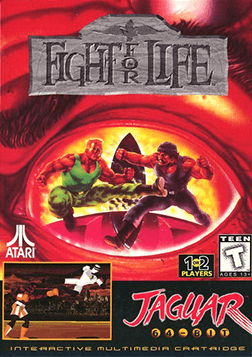Fight for Life (video game)
| Fight for Life | |
|---|---|
 | |
| Developer(s) | Atari |
| Publisher(s) | Atari |
| Platform(s) | Atari Jaguar |
| Release date(s) |
|
| Genre(s) | Versus fighting |
| Mode(s) | Single player, multiplayer |
Fight for Life is a video game developed and published by Atari for its Jaguar system in 1996. It was the last game released for the Jaguar before Atari dropped support for the platform.
History
In 1994, Atari hired Sega AM2 programmer Francois Bertrand to work on a 3D Fighting game for the Jaguar.[1] Bertrand's previous experience was in developing the camera and collision systems for Sega's Virtua Fighter polygon fighter, and he served as the lead (and only) programmer on Fight for Life.
The company BioVision assisted in development, and all the game's moves were recorded using their motion capture system.[2]
The 3D format and polygon graphics were intentionally modeled after Sega's Virtua Fighter and Namco's Tekken arcade games that were scheduled to be translated for the companies' respective home systems.
The game was completed in December 1995, approximately 19 months after development began. Atari released the game in 1996. Fight for Life was the first and only 3D fighting game to appear on the Jaguar console.
Story
In the single player mode, the player controls one of the eight deceased characters in a tournament battle to escape from hell and get a second chance at life.
The characters in the game are:
- Kimura, a ninja
- Ian, a soldier
- Kara, an American mom
- Pog, a dock worker
- Mr. G, a professional boxer
- Muhali, an Arabian fighter
- Jenny, a worldwide girl
- Lun, a Kung Fu master
Gameplay
Fight for Life is a 3D polygon-based fighting game. The gameplay mechanics were very similar to Virtua Fighter's, but with two notable exceptions. First is that the player begins the game with no special moves. The player has the ability to "steal" two special moves away from defeated opponents. In this way, the player is able to build a unique fighter.
Second, unlike all but a few fighting games available at that time, fighters could actually maneuver in 3D. The characters accomplish this by sidestepping, allowing them to move around the arena in a counter-clockwise direction while still facing their opponent.
Reception
Most video game magazine critics panned the video game for its weak graphics and sound; Electronic Gaming Monthly's Seanbaby put it as #3 in his "20 worst games of all time" feature.[3]
References
- ↑ Atari Gaming Headquarters interview with Francois Bertrand
- ↑ "Atari Picks a Fight". GamePro (66). IDG. January 1995. pp. 211–212.
- ↑ Seanbaby.com